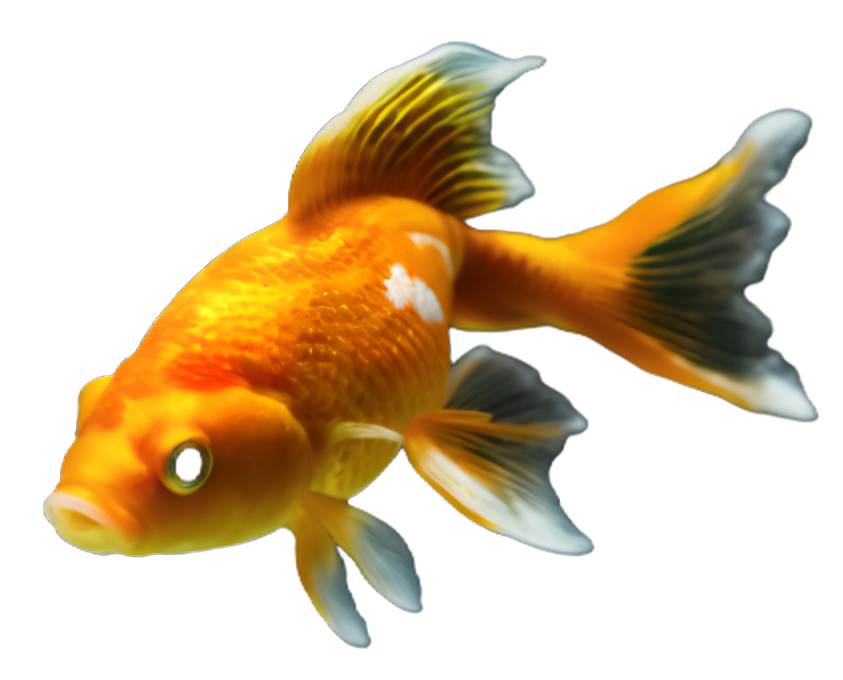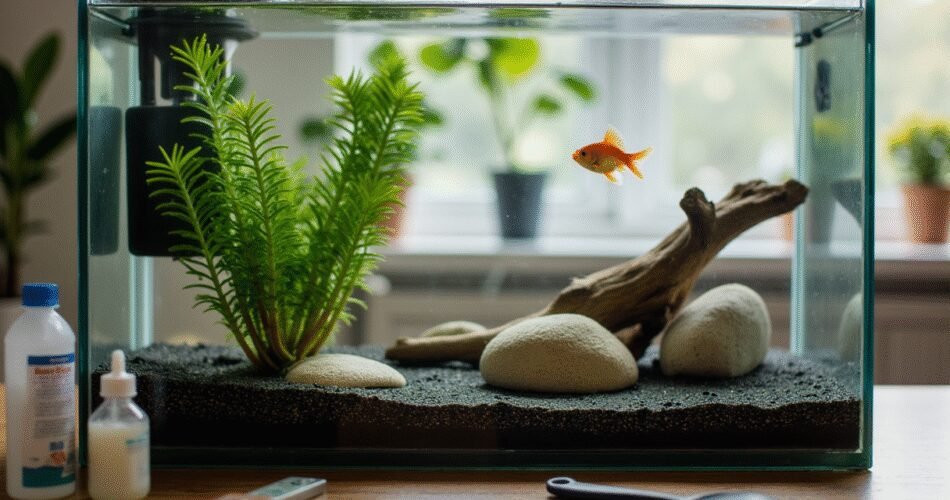Introduction to Setting Up a Goldfish Tank 🐠
I absolutely love keeping goldfish—they’re beautiful, lively, and full of personality, but I’ve learned the hard way that a proper goldfish tank setup isn’t just about tossing a bowl with water. If you’re new to this, getting started the right way is essential for your fish to thrive.
In this guide, I’ll walk you through goldfish tank basics for beginners, covering everything from choosing the right tank size and filter to creating a healthy environment. Whether you’re wondering how to start a goldfish tank or just want to ensure top-notch care, I’ve got you covered. Let’s dive in!
Choosing the Right Tank Size for Your Goldfish 🏡
I can’t stress enough how much the goldfish tank size matters. If you’re wondering about the minimum tank size for goldfish, let me tell you: bigger is always better. Goldfish produce a ton of waste, and cramped conditions lead to poor water quality, stunted growth, and stress. A small tank just won’t cut it.
For fancy goldfish, I start with at least 20 gallons for the first fish and add 10–15 gallons for each extra one. Common or comet goldfish need even more space—think 40 gallons for one and another 20–30 gallons per additional fish. These goldfish aquarium size recommendations give them room to swim and grow properly.
When I pick the best tank for goldfish, I always go for a rectangular shape over tall or bow-front designs. More surface area means better oxygen exchange. And I always plan for the future—my goldfish thank me for it!
Selecting Proper Filtration Systems 🔄
If I’m setting up a goldfish tank, choosing the right aquarium filtration system is non-negotiable. Goldfish are messy, and without effective filtration, water quality plummets fast. I rely on three main types of goldfish tank filter options: sponge filters, hang-on-back (HOB) filters, and canister filters.
Sponge filters are gentle and great for small tanks or fry. HOB filters are user-friendly and offer solid mechanical and biological filtration—perfect if you’re starting out. For larger setups, canister filters provide superior cleaning power, though they’re a bit more complex.
When I pick the best filter for your goldfish tank, I go for one rated for a tank larger than mine. Goldfish produce more waste than most fish, so over-filtering is my friend. For beginners, I’d start with a reliable HOB filter—it’s efficient, affordable, and easy to maintain. Learning how to filter a goldfish aquarium properly means cleaner water, healthier fish, and less stress for me.
Setting Up the Tank Environment: Substrate and Decorations 🌿
When I set up my goldfish tank, I always start with choosing the right goldfish tank substrate. For me, the best option is fine, smooth sand or rounded gravel—anything too coarse or small can be a choking hazard. I make sure the substrate is safe for goldfish tank setups, so I avoid anything sharp or chemically treated.
Next, I pick decorations for my goldfish aquarium that are both fun and functional. Smooth rocks, driftwood, and artificial plants work well, as long as they don’t have rough edges. I arrange everything to create open swimming areas and hiding spots, which keeps my goldfish active and comfortable. It’s all about balancing safety with stimulation!
Filling and Cycling the Tank Water 💧
Cycling a goldfish tank is the most important step I take before adding any fish. It’s all about establishing the nitrogen cycle—the natural process where beneficial bacteria break down harmful waste like ammonia into less toxic substances. Without a fully cycled tank, ammonia and nitrites can spike and harm or even kill my goldfish. That’s why I never skip this process.
Here’s how I cycle aquarium water for goldfish: I start by setting up the tank with a filter and dechlorinated water. Then, I add an ammonia source, like fish food or pure ammonia, to kickstart the cycle. Over 4–6 weeks, I test the water regularly to monitor goldfish tank water parameters—ammonia and nitrite should rise and then drop to zero, while nitrates stay low. Only when ammonia and nitrite read zero do I know the tank is safe.
For tank water preparation, I always use a water conditioner to remove chlorine and chloramines. I match the temperature and pH to my goldfish’s needs, keeping things stable. Regular partial water changes help maintain ideal conditions once my fish are in their new home.
Choosing and Introducing Goldfish to the Tank 🐟
When I’m selecting goldfish, I always look for clear signs of health. I check for bright eyes, intact fins, and active swimming—no clamped fins or spots. I avoid fish that look lethargic or are hiding away. It’s crucial to pick fish that seem energetic and curious; that’s how I know I’m bringing home a healthy goldfish.
Before introducing goldfish to my aquarium, I quarantine them. I keep new fish in a separate tank for two to three weeks to watch for illness. This step prevents introducing parasites or infections into my main tank. It’s a simple habit that saves me a lot of stress down the line.
When it’s time to move them, I acclimate them slowly. I float the bag in the tank to equalize the temperature, then gradually mix in small amounts of tank water over about 30 minutes. Only then do I release them. This gentle introduction helps reduce shock and gives my new goldfish the best start in their forever home—the tank I set up just for them.
Maintaining Water Quality and Tank Cleanliness 🧽
I start with weekly water changes, swapping out about 20% of the tank water to keep things fresh and reduce waste buildup. For goldfish tank maintenance, this is non-negotiable—it’s the simplest way to maintain water quality for goldfish.
When I clean the tank, I use a gravel vacuum to suck up debris from the substrate without disturbing the beneficial bacteria. I also wipe down the inside glass to prevent algae from taking over. Learning how to clean a goldfish tank properly means avoiding soap or harsh chemicals—rinse everything in tank water only.
Testing water parameters weekly is key. I check ammonia, nitrite, nitrate, and pH levels to catch any issues early. Keeping these stable is crucial for maintaining aquarium water quality and preventing stress or disease in my goldfish.
A clean tank isn’t just about looks—it’s about creating a healthy, stable environment where my goldfish can thrive.
Feeding Your Goldfish Properly 🍽️
When it comes to feeding goldfish, I’ve learned that getting their diet right is crucial. Goldfish need a balanced mix of proteins, vitamins, and fiber to thrive. For beginners like me, high-quality pellets or flakes designed specifically for goldfish are the easiest options. I also occasionally offer blanched veggies like peas for variety.
I stick to a simple goldfish feeding schedule: small portions twice a day, only what they can finish in a couple of minutes. Overfeeding is a common mistake I avoid—it leads to poor water quality and health issues. Remember, a hungry goldfish is a healthy goldfish!
Monitoring Goldfish Health and Behavior 👀
When I observe my goldfish, I focus on their activity, appetite, and appearance to assess their goldfish health. A healthy goldfish is active, swims smoothly, and eagerly eats during feeding times. Clear eyes, intact fins, and vibrant colors are key signs of healthy goldfish.
I also pay close attention to changes in goldfish behavior. Lethargy, clamped fins, or rubbing against tank decor can signal stress or illness. Common goldfish diseases include fin rot, ich, or swim bladder issues—often noticeable through visible spots, frayed fins, or abnormal swimming.
If I spot any of these symptoms, I act quickly. I check water quality first, as poor conditions often cause health problems. For persistent issues, I don’t hesitate to consult a vet. Setting up the right tank environment from the start is crucial for prevention.
Conclusion and Tips for Sustainable Goldfish Keeping 🌟
When I first started with goldfish, I learned that proper goldfish care tips aren’t just a one-time thing—they’re about consistency. Start with a spacious tank, a reliable filter, and regular water checks. That’s the foundation of sustainable goldfish keeping.
For long-term goldfish care advice, stick to a routine: feed sparingly, change 20% of the water weekly, and keep an eye on behavior and water quality. It’s not complicated, but it requires attention.
My top beginner goldfish tank tips? Don’t overcrowd, avoid sharp decorations, and always use a water conditioner. These small steps make a huge difference.
Remember, keeping goldfish is a commitment. They rely on you for a healthy, happy life. Choose responsibly, care consistently, and enjoy the journey.

